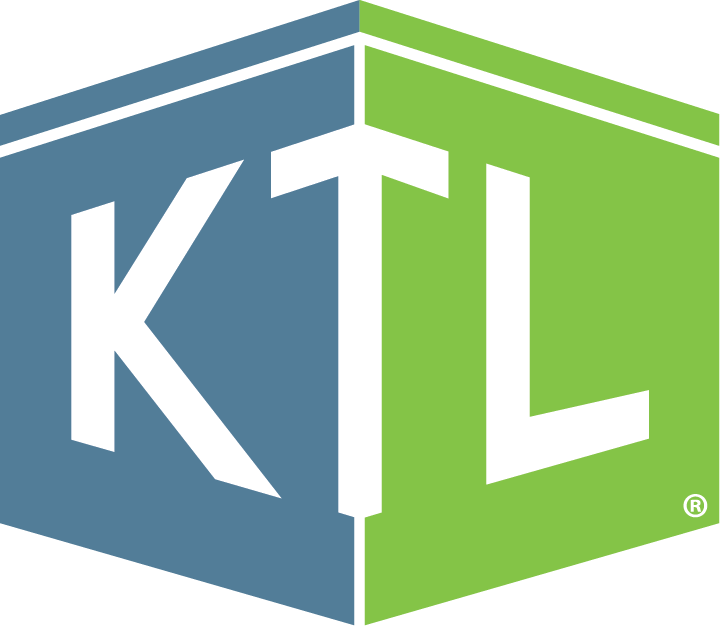
Tech Corner: OSHA 300 Log Management
Functionality: What does it do?
The Occupational Safety and Health (OSH) Act requires certain employers to prepare and maintain records of work-related injuries and illnesses. Employers must keep an OSHA 300 Log and OSHA 300A Summary for each establishment or site that documents specific details when an incident occurs. KTL’s OSHA 300 PowerApp is a comprehensive intake form tailored to OSHA 300 and OSHA 300A requirements that makes it easier to collect, search, and analyze data—and maintain OSHA compliance.
Benefits: Why do you need it?
KTL’s OSHA 300 PowerApp provides the following:
- Easier data entry. The app guides users through all required OSHA questions to help ensure no crucial data points are missed.
- Reduced errors. The intuitive design and in-built checks reduce the chances of errors, leading to more accurate reporting.
- Improved searchability. Microsoft Dataverse provides quick and efficient access to stored records. The digital format makes it easy to filter, search, and analyze records and data to offer deeper insights into safety performance.
- Mobility. The PowerApp can be accessed from any device, anytime, anywhere, making the reporting process more flexible.
- Data security. Log entries are stored safely, ensuring data integrity and security.
- Improved visualization. Incident data can be viewed in real-time as two paginated reports:
- OSHA 300 Log: Detailed record of work-related injuries and illnesses.
- OSHA 300A: Summary of the OSHA 300 Log, which can be displayed prominently at workplaces.
Technology Used
- PowerApps
- Microsoft Dataverse
- Power BI
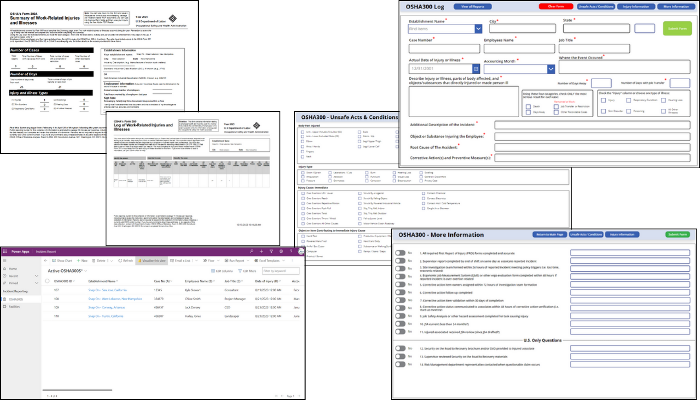

Tech Corner: Customer Complaints Log
Functionality: What does it do?
Whether a company sells directly to consumers or to other manufacturers, managing, monitoring, responding to, and trending customer complaints is an important part of a risk management strategy. KTL’s customer complaints log provides a central location for companies to capture and respond to customer complaints—and then trend that data to ensure complaints are tracked to closure and any necessary changes are made to alleviate company risk.
Benefits: Why do you need it?
A web-based customer complaints log:
- Simplifies collection of customer complaint information via electronic forms.
- Aggregates all customer complaints in one central database to support the management and trending of customer complaint data.
- Documents, assigns, and tracks resolution of customer complaints.
- Establishes follow-up action requirements and associated deadlines to ensure any required changes are made.
- Helps manage the risks associated with customer complaints and potential recalls.
- Meets certification standard requirements for complaint management (e.g., Global Food Safety Initiative (GFSI)).
Technology Used
- Power Apps: Creates customized forms and applications for data capture and initial complaint logging.
- Power BI: Allows for advanced analytics, data visualization, and trending of customer complaint data.
- Power Automate: Automates the workflow, task assignments, reminders, and follow-up actions related to complaints.
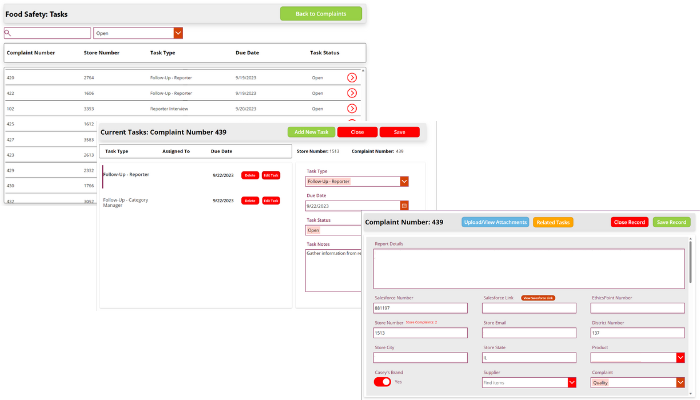
Tech Corner: Training Tracking
Functionality: What does it do?
Training is a key component of maintaining ongoing compliance—whether with regulatory requirements, supply chain mandates, or internal policies. Having a system that records employee training is critical, especially to ensure policies, procedures, and work instructions are followed. KTL’s training tracking systems allow for the centralized implementation, management, tracking, scheduling, assignment, and analysis of organizational training efforts.
Benefits: Why do you need it?
A web-based training tracking system can help:
- Outline and document training requirements.
- Create training plans and workflows for scheduling training and assignments by job title and function.
- Ensure competency through online quizzes.
- Log and track training and certifications completed—including classes, required reading, online education, CEUs, and outside certifications.
- Track certification/training expirations and send notifications to complete training.
- Create individual dashboards and training reports for managers and employees, improving accessibility of training expectations and records.
- Demonstrate compliance with regulatory requirements for training.
Technology Used
- SharePoint to store the training data
- PowerApps to record and manage course information
- Power Automate for email notifications
Tech Corner: Permit Tracking
Functionality: What does it do?
Depending on the breadth and location(s) of a company’s operations, managing permits and their associated requirements and due dates without a centralized system in place can present significant challenges: How many permits does your operating system have–and what are the associated requirements? Who is responsible? Are there key/critical dates? How do you manage all that information and verify compliance? KTL’s permit tracking tool provides a central repository to track, manage, and communicate permit activity tracking.
Benefits: Why do you need it?
A web-based permit tracking system can help:
- Catalog and track permits and associated requirements and timeframes in one database.
- Manage change information.
- Store critical documents for easy access and effective record control.
- Send and receive notifications of permits about to expire.
- Coordinate and communicate with project contractors.
- Establish accountability and a standardized approach for reporting, monitoring, and performance measurement.
- Improve permit compliance assurance reliability, efficiency, and consistency.
Technology Used
- Microsoft Power Automate: send/receive notifications
- Canvas PowerApp: catalog permits, trigger notifications, create user interface
- SharePoint Lists: tracking changes, store data
- SharePoint Document Library: store attachments, permits, contracts, etc.
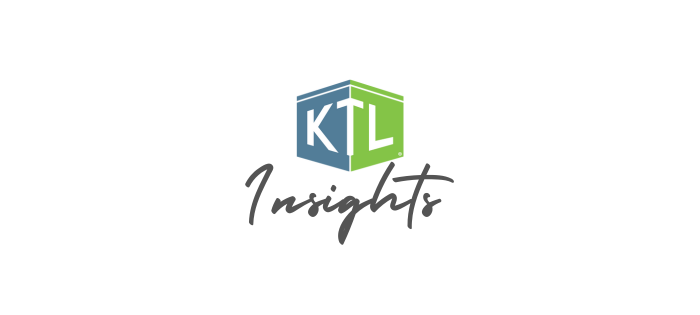
Tech Corner: Electronic Standards Register
Functionality: What does it do?
Certification standards are designed to ensure an organization’s customers, suppliers, and stakeholders that its products/services meet best practices. Each of these standards (e.g., ISO, GFSI, industry-specific) has a set of requirements that must be met to achieve certification. An electronic standards register organizes all of an organization’s standards requirements into an online tool, allowing for better management, tracking, and overall compliance.
Benefits: Why do you need it?
An electronic standards register:
- Assists with compliance demonstration and document control by allowing mapping of documents to specific certification standard requirements.
- Facilitates activities during remote or onsite audits.
- Ensures standard version support during future updates.
- Identifies common requirements and allows documentation to be linked between standards, as needed.
- Allows the internal audit team to complete and keep notes for the internal audit.
Technology Used
SharePoint

Tech Corner: CAPA Tracking Log
Functionality: What does it do?
Corrective and preventive actions (CAPAs) are those actions an organization takes to make improvements and/or eliminate causes of non-conformities. The CAPA Tracking Log records, assigns, and tracks CAPAs to closure. This is important, as failure to implement and close a CAPA may be considered a major non-conformance.
KTL’s CAPA Tracking Log also tracks recommendations to improve. Unlike CAPAs, recommendations do not correct a non-conformance; rather, they are suggestions to refine or improve processes.
Benefits: Why do you need it?
The CAPA Tracking Log provides the following:
- Records, assigns, and tracks CAPAs to closure.
- Assigns tasks to specific team members.
- Communicates due dates and sends notifications when tasks are overdue.
- Facilitates verification of completed activities and associated documentation.
- Prevents the occurrence and/or recurrence of issues.
- Optimizes processes and ensures that deliverables are free from defects and other non-conformities.
Technology Used
- SharePoint
- Power Automate

Tech Corner: Document Management
Functionality: What does it do?
A document/records management system creates a company-wide framework for central and secure storage and organization of and access to documents and records. Having a good document management system is essential for maintaining the vast number of documents required by regulations and standards, particularly since some have retention cycles for as long as 30 years.
Benefits: Why do you need it?
Document management provides the following:
- Central and secure storage, organization, and access to documents and records locally or remotely.
- Process and document standardization.
- Higher quality data due to reduced human error.
- Improved collaboration and dissemination of document updates to staff.
- Improved document searchability and accessibility.
- Enhanced workflows for approving and completing tasks involving documents.
- Easy access for audits and clear audit trail.
- Version control and history.
- Reduced paperwork.
- Ease in uploading documents (similar to a shared network drive) and adding/updating metadata for searchability.
- Improved security of sensitive documents (permissions that can be applied at the document level).
All of which lead to more consistent, efficient, and reliable compliance performance.
Technology Used
SharePoint

Tech Corner: Dashboards
Functionality: What does it do?
A dashboard is a tool used to quickly display and visualize data, typically using charts, tables, and other graphic elements. Dashboards provide a quick and simplified way for users to understand complex data sets, review key performance indicators (KPIs), and identify trends or patterns.
The data collected in most business processes—ranging from the outputs of an inspection form to the inputs into a companywide sales program—can be displayed in a dashboard. For example:
- Forklift Pre-Op Inspection Dashboard: A dashboard could be set up to track and visually display when the inspection form is being filled out, by whom, what types of issues are being identified, how frequently they are identified, and what outstanding issues need to be closed. These dashboards can help identify trends and improve overall management of the inspection program.
- Marketing and Sales Dashboard: Marketing and Sales departments rely heavily on metrics. Dashboards allow the end user to visualize data that is being tracked, such as advertising return on investment, engagement, growth, revenue, website traffic, sales pipeline, etc. These dashboards can help with sales forecasting and informing marketing decisions.
- Homepage Dashboard: Homepage dashboards are often used as internal landing pages that display important data related to the company and/or specific projects. These might be formatted to contain key metrics, important documents, sales data, assigned tasks, etc. They provide a quick, at-a-glance view of relevant data and information.
Benefits: Why do you need it?
- Dashboards provide an integrated view of data pulled from multiple sources into an easy-to-read display.
- Simplified data visualization allows for improved and more efficient decision-making.
- Dashboards metrics provide for real-time monitoring of data as it is being collected.
- The collaboration, customization, and transparency provided through dashboards help support organizational objectives.
Technology Used
- Excel
- Power Apps
- Power BI
- SharePoint
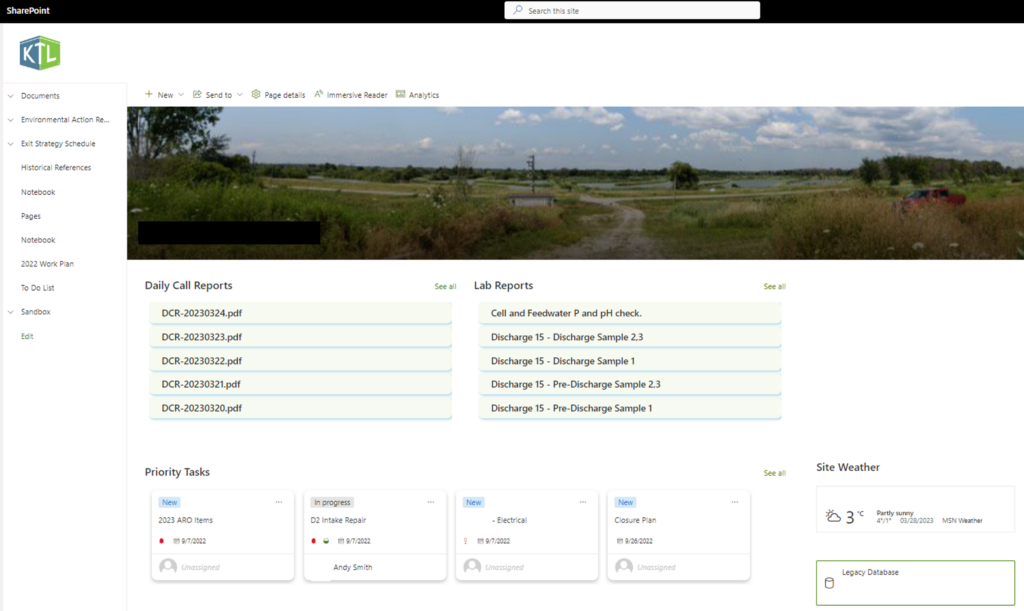

Tech Corner: Forklift Pre-Op Inspection Form
Functionality: What does it do?
A pre-operation forklift inspection is used by forklift operators to conduct safety and maintenance checks prior to operation. The intent of the inspection is to reduce the likelihood of avoidable injuries caused by forklifts. Typically, these inspections are done via paper forms. The KTL forklift inspection tool creates a mobile form for electronic data collection in the plant/field. Inspection data is submitted directly to the system and can then be further analyzed through dashboards to identify concerns and trends. Notifications for identified issues and program compliance can also be configured to create greater visibility of the forklift safety program.
Benefits: Why do you need it?
- Data can be submitted directly and immediately for review with no manual data entry required.
- Data is stored for future analysis and improvements.
- Issues with forklifts can be identified quickly and assigned to relevant people for resolution.
- Program compliance is tracked in real time.
Technology Used
- Power Automate
- Power Apps or alternative
- Power BI

EHS Trends to Watch in 2023
Every year, we see a number of environmental, health, and safety (EHS) trends rise to the surface that have the potential to impact many industries. Some challenges and opportunities in EHS remain ongoing; some are just gaining traction with impacts yet to be known. Regardless, the start of a new year provides the opportunity to plan for EHS issues and trends on the horizon and prioritize efforts to ensure ongoing compliance.
Here are some of the top EHS trends KTL is keeping watch on in 2023—and some guidance to help you as you set your EHS strategy for the new year.
Resource Constraints and Technology Solutions
EHS personnel are being asked to manage a lot—and often in growing areas that may be outside their education, expertise, and/or experience. Resource constraints—particularly related to staffing—remain a significant concern across industry, and EHS is certainly not immune. Impacts from the “Great Resignation” of November 2021 and beyond continue to leave many companies without the resources needed to effectively manage EHS requirements.
Achieving and maintaining EHS compliance requires great management and expertise to ensure all aspects of a company’s technical compliance have been identified and are being actively handled. KTL has been working with more and more EHS departments to fill these gaps—either with outsourced personnel or compliance efficiency tools—as companies look to recruit EHS staff and meet compliance obligations.
Guidance:
- Develop a relationship with someone you trust to do things in your best interest, understanding that EHS should be a process of continuous improvement. Use them to help you understand what regulations apply. Let them help you prioritize your compliance plan. Use them to do your annual training. Rely on them as a part of your team.
- Employ information technology (IT) solutions to create compliance efficiencies. A well-designed and executed compliance information management system brings IT and management systems together to coordinate, organize, control, analyze, and visualize information in such a way that helps organizations remain in compliance and operate efficiently. A system like this will help provide operational flexibility, generate business improvement, and prepare organizations to address these and other EHS compliance challenges that will continue to surface.
EPA Inspections and Enforcement
EPA intends to continue its enforcement path, holding environmental violators and responsible parties accountable. Significant investments are being made to enforce and ensure compliance with the nation’s environmental laws, including $213 million for civil enforcement efforts, $148 million for compliance monitoring efforts, and $69 million for criminal enforcement efforts. The Agency also has plans to improve inspections by sending 75% of EPA inspection reports to facilities within 70 days of inspection and conducting 55% of annual EPA inspections at facilities that affect communities with potential environmental justice (EJ) concerns (see more on EJ below).
Guidance:
- Design and maintain a safe facility to prevent accidental releases and minimize the consequences of accidental releases that do occur. Conduct a gap assessment to ensure the required processes and systems are functioning as intended.
- Establish a quick response internal inspection team that can evaluate all areas of risk in your facility to ensure you are in compliance, particularly at the time of inspection.
- Understand the hazards posed by chemicals at the facility and assess the impacts of a potential release. Complete a waste characterization for all hazardous and solid waste streams to make sure you are appropriately managing your universal waste and hazardous waste.
- Check your Emergency Response Plan to ensure it has identified emergency contacts for your facility and that the contacts are current. Coordinate with local emergency responders.
Environmental Justice (EJ)
EPA’s Strategic Plan includes a goal that EJ and civil rights will be embedded into EPA’s programs, policies, and activities to reduce disparities in environmental and public health conditions. This focus on EJ has continued to gain momentum with a slew of additional significant actions taken in 2022 to further elevate EJ priorities and deliver on the Administration’s promises to advance justice and equity when it comes to ensuring clean air and water for all communities; safeguarding and revitalizing communities (i.e., Superfund and RCRA); and ensuring safety of chemicals through civil rights and compliance reviews, audits, and community outreach.
Guidance:
- Take the time to understand the communities where you operate—be informed, be prepared, and be proactive. Establish companywide priorities and goals and commit the appropriate resources to address EJ concerns.
- There are a number of EJ grants, funding, and other technical assistance available. EPA’s new Office of Environmental Justice and External Civil Rights is positioned to deliver new grants and technical assistance to meet EJ goals.
Sustainability and Climate Change
The Biden Administration previously committed to a net zero economy by 2050. EPA is focused on reducing greenhouse gas (GHG) emissions by promulgating rules to reduce pollution from the power sector, setting vehicle emission standards, and partnering with the public and private sectors communities (especially those underserved and disproportionally at risk) to increase energy efficiency in the residential, commercial, and industrial sectors. In addition, there is $100 million in grants to support efforts to reduce GHG emissions and increase resiliency in the nation’s infrastructure and $35 million to implement the American Innovation in Manufacturing Act to continue phasing out GHGs.
Guidance:
- Conduct a lifecycle analysis (LCA) to identify and quantify the inputs and outputs in a process and use data to assess the potential environmental impacts across the lifecycle.
- Have an energy audit completed of your facilities.
- Get input from employees on what initiatives are important to them by enacting a sustainability committee or adding sustainability to your EHS agenda.
Safer Communities by Chemical Accident Prevention (SCCAP)
EPA proposed on August 31, 2022 to strengthen the Risk Management Program (RMP) regulations with the SCCAP proposed rule. The proposed SCCAP amendments include a number of requirements that were originally promulgated by the Obama Administration EPA in 2017 and subsequently rescinded during the Trump Administration in 2019, plus several new requirements considering impacts of climate change, EJ concerns, employee participation, and enhanced community notification. Proposed changes would require RMP-regulated facilities to better consider surrounding communities and the consequences of potential chemical accidents that could have significant impacts on industry requirements going forward.
Guidance:
- Identify/understand/prioritize your compliance risks and develop strategies to minimize them to the extent possible.
- Outline steps to improve performance and safe operations, including defining organizational roles and responsibilities. Plan and conduct required tabletop exercises and coordinate with Local Emergency Planning Committees (LEPCs) to ensure your plans work in practice.
- Streamline compliance methods and improve operational efficiencies by implementing IT solutions and compliance management systems that coordinate, organize, control, analyze, and visualize information.
PFAS Contamination
More and more facilities are going to be directly impacted by mitigation efforts and future regulatory action related to per- and polyfluoroalkyl substances (PFAS). PFAS contamination is an extremely complicated issue—and concern is mounting over its impacts and how to regulate these chemicals going forward. EPA has set aside $126 million to increase its understanding of human health and ecological effects of PFAS contamination, restrict its uses, and remediate PFAS that have been released. Over the course of 2022, EPA took several actions to further protect individuals and communities from the health risks posed by these forever chemicals and more is on the way.
Guidance:
- Evaluate your current environmental risk level and develop strategies to minimize risks to the extent possible. Proper usage strategies, a comprehensive environmental management system (EMS), and a forward-thinking Emergency Response Plan will remain vital tools for companies potentially dealing with PFAS to effectively manage the associated risks.
- Work with LEPCs to coordinate emergency response efforts and exercises to keep communities informed and safe.
Set Your Goals for 2023
With these trends toward more regulation, more enforcement, and more focus on EJ and sustainability—but with fewer resources to manage it all—companies need to accurately assess compliance requirements and create a plan for how to meet them. KTL suggests completing the following early in 2023:
- Get senior leadership commitment. It is often clear how an organization prioritizes EHS with little digging. Even with the best EHS personnel, the organization and its EHS system will only be as good as the top leadership and what is important to them.
- Conduct a comprehensive gap assessment to ensure you are meeting the requirements of all applicable EHS regulations. This should be the starting place for understanding your regulatory obligations and current compliance status.
- Perform a comprehensive onsite risk assessment with associated risk minimization planning and plan/conduct annual spill drills to practice emergency response for hazardous chemical incidents.
- Organize your records. Know what records you need. Document your inspections and your training. Develop standard operating procedures (SOPs) so people know what to do.
- Create an integrated management system (e.g., ISO 9001/14001/45001) by finding commonalities between the standards and leveraging pieces of each to develop a reliable system that works for your organization. Implement IT solutions to streamline compliance and create business efficiencies.
- Seek third-party oversight. Having external experts periodically look inside your company provides an objective view of what is really going on, helps you to prepare for audits, and allows you to implement corrective/preventive actions that ensure compliance.
